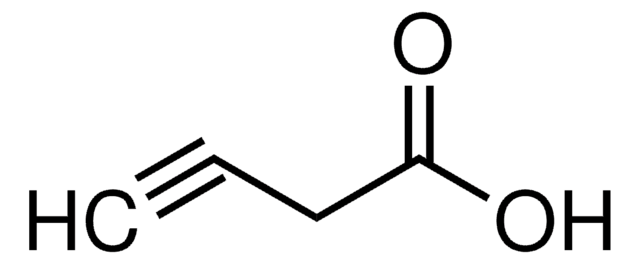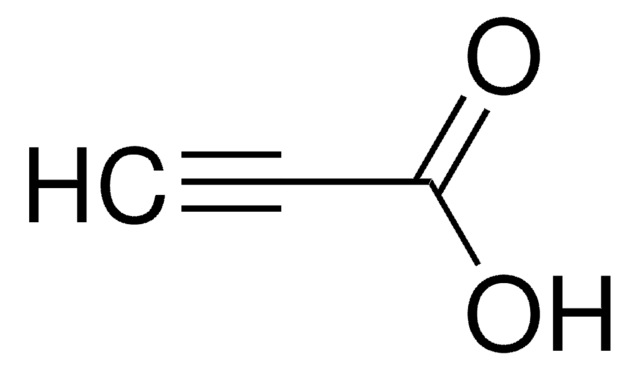544000
5-Hexynoic acid
97%
Synonym(s):
4-Ethynylbutyric acid, 5-Hexyn-1-oic acid
Sign Into View Organizational & Contract Pricing
All Photos(1)
About This Item
Linear Formula:
CH≡C(CH2)3CO2H
CAS Number:
Molecular Weight:
112.13
Beilstein:
1743192
MDL number:
UNSPSC Code:
12352100
PubChem Substance ID:
NACRES:
NA.22
Recommended Products
Quality Level
Assay
97%
refractive index
n20/D 1.449 (lit.)
bp
224-225 °C (lit.)
density
1.016 g/mL at 25 °C (lit.)
functional group
carboxylic acid
SMILES string
OC(=O)CCCC#C
InChI
1S/C6H8O2/c1-2-3-4-5-6(7)8/h1H,3-5H2,(H,7,8)
InChI key
VPFMEXRVUOPYRG-UHFFFAOYSA-N
Looking for similar products? Visit Product Comparison Guide
Related Categories
General description
5-Hexynoic acid is an alkynoic acid. It undergoes gold-catalyzed cyclization to form the corresponding methylene lactones.
Application
5-Hexynoic acid may be used in the preparation of:
- 5-hexynoic acid methyl ester
- 5,6-dicarba-closo-dodecaboranyl hexynoic acid
- 5,8,11-dodecatriynoic acid
- 5-isocyanato-1-pentyne
Signal Word
Warning
Hazard Statements
Precautionary Statements
Hazard Classifications
Eye Irrit. 2 - Skin Irrit. 2 - STOT SE 3
Target Organs
Respiratory system
Storage Class Code
10 - Combustible liquids
WGK
WGK 3
Flash Point(F)
230.0 °F - closed cup
Flash Point(C)
110 °C - closed cup
Personal Protective Equipment
dust mask type N95 (US), Eyeshields, Gloves
Choose from one of the most recent versions:
Already Own This Product?
Find documentation for the products that you have recently purchased in the Document Library.
Customers Also Viewed
A mild access to ?-or ?-alkylidene lactones through gold catalysis.
Harkat H, et al.
Tetrahedron Letters, 47(35), 6273-6276 (2006)
Synthesis of a Tyr3-octreotate conjugated closo-carborane [HC2B10H10]: a potential compound for boron neutron capture therapy.
Schirrmacher E, et al.
Tetrahedron Letters, 44(51), 9143-9145 (2003)
Synthesis of 5, 8, 11-dodecatriynoic acid and its use in the synthesis of arachidonic acid and related acids.
Fryer RI, et al.
The Journal of Organic Chemistry, 40(3), 348-350 (1975)
Cobalt-catalyzed cocyclizations of isocyanato alkynes: a regiocontrolled entry into 5-indolizinones. Application to the total synthesis of camptothecin.
Earl RA and Vollhardt KPC.
Journal of the American Chemical Society, 105(23), 6991-6993 (1983)
Juan M Castro et al.
Scientific reports, 9(1), 165-165 (2019-01-19)
The self-reproduction of supramolecular assemblies based on the synthesis and self-assembly of building blocks is a critical step towards the construction of chemical systems with autonomous, adaptive, and propagation properties. In this report, we demonstrate that giant vesicles can grow
Our team of scientists has experience in all areas of research including Life Science, Material Science, Chemical Synthesis, Chromatography, Analytical and many others.
Contact Technical Service














